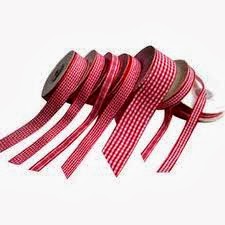Ribbon:
A Ribbon is a long, narrow strip of material used for decoration of clothing or the hair or gift wrapping; An inked strip of material against which type is pressed to print letters in a typewriter or printer; A toolbar that incorporates tabs and menus; to decorate with ribbon.We can also say a Ribbon is a thin band of flexible material, typically cloth but also plastic or sometimes metal, used primarily for binding and tying. Cloth ribbons, which most commonly includes silk, are often used in connection with dress, but also applied for innumerable useful, ornamental and symbolic purposes; cultures around the world use this device in their hair, around the body, or even as ornamentation on animals, buildings, and other areas. Ribbon is also sometimes used as a package sealer, on par with twine.
Types of Ribbon
The manufacture of cloth ribbons forms a special department of the textile industries. The essential feature of a ribbon loom is the simultaneous weaving in one loom frame of two or more webs, going up to as many as forty narrow fabrics in modern looms. To effect the conjoined throwing of all the shuttles and the various other movements of the loom, the automatic action of the power-loom is necessary and it is a remarkable fact that the self-acting ribbon loom was known and extensively used more than a century before the famous invention of Cartwright.
History of Ribbon
Ribbon-weaving is known to have been established near St. Etienne (dep. Loire) as early as the 11th century, and that town has remained the headquarters of the industry. During the Huguenot troubles, ribbon-weavers from St. Etienne settled at Basel and there established an industry which in modern times has rivalled that of the original seat of the trade. Crefeld is the centre of the German ribbon industry, the manufacture of black velvet ribbon being there a specialty. In England Coventry is the most important seat of ribbon-making, which is also prosecuted at Norwich and Leicester.
Ribbons are enjoyed by many people as a common decoration. In some cultures birthday gifts are adorned with these colorful strings.
While satin and other sorts of ribbon have always been used in lingerie, the usage of ribbon in the garment industry, while subject to fashion trends, saw an upsurge in the mid to late 90’s. This upsurge led to increased ribbon manufacturing as well as new and improved manufacturing techniques. Due to more competitive production rates, as well as past experience in this field, companies in the Far Eypesast - especially those in China - gradually secured themselves to be the major ribbon suppliers in the world and improved both the quality and the variety of their merchandise to match those of their established European and North American competitors.
Presently, the North American continent remains the largest importer of ribbon and ribbon derivative products (such as bows, rosettes, and other garment accessories made from ribbon). However, due to outsourcing of production of garments by North American garment manufacturers, countries in Asia and South America have started to contribute to the change of the statistical figures of ribbon imports.
Inspired by European silk ribbons obtained through trade, Great Lakes and Prairie Native American tribes created art form of appliqué ribbon work.
 |
| Garments Ribbon |
- Grosgrain Ribbon
- Satin Ribbon
- Velvet Ribbon
- Offray Ribbon
- lace Ribbon
- Turquoise Ribbon
The manufacture of cloth ribbons forms a special department of the textile industries. The essential feature of a ribbon loom is the simultaneous weaving in one loom frame of two or more webs, going up to as many as forty narrow fabrics in modern looms. To effect the conjoined throwing of all the shuttles and the various other movements of the loom, the automatic action of the power-loom is necessary and it is a remarkable fact that the self-acting ribbon loom was known and extensively used more than a century before the famous invention of Cartwright.
History of Ribbon
Ribbon-weaving is known to have been established near St. Etienne (dep. Loire) as early as the 11th century, and that town has remained the headquarters of the industry. During the Huguenot troubles, ribbon-weavers from St. Etienne settled at Basel and there established an industry which in modern times has rivalled that of the original seat of the trade. Crefeld is the centre of the German ribbon industry, the manufacture of black velvet ribbon being there a specialty. In England Coventry is the most important seat of ribbon-making, which is also prosecuted at Norwich and Leicester.
Ribbons are enjoyed by many people as a common decoration. In some cultures birthday gifts are adorned with these colorful strings.
While satin and other sorts of ribbon have always been used in lingerie, the usage of ribbon in the garment industry, while subject to fashion trends, saw an upsurge in the mid to late 90’s. This upsurge led to increased ribbon manufacturing as well as new and improved manufacturing techniques. Due to more competitive production rates, as well as past experience in this field, companies in the Far Eypesast - especially those in China - gradually secured themselves to be the major ribbon suppliers in the world and improved both the quality and the variety of their merchandise to match those of their established European and North American competitors.
Presently, the North American continent remains the largest importer of ribbon and ribbon derivative products (such as bows, rosettes, and other garment accessories made from ribbon). However, due to outsourcing of production of garments by North American garment manufacturers, countries in Asia and South America have started to contribute to the change of the statistical figures of ribbon imports.
Inspired by European silk ribbons obtained through trade, Great Lakes and Prairie Native American tribes created art form of appliqué ribbon work.
No comments:
Post a Comment